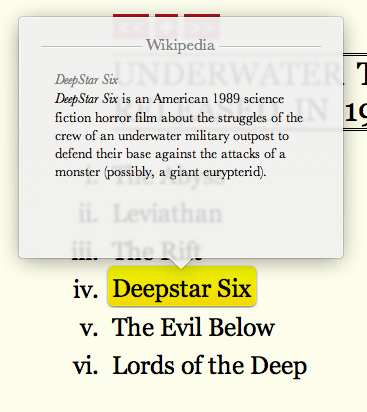People have been making lists long before the World Wide Web was just a glimmer in the eye of Tim Berners-Lee. But for several reasons, the internet really multiplied the publishing of lists like fruit flies in a genetics lab. And they really do seem to be one of the internet’s favorite pastimes. Indeed, there are even multiple meta–lists to tell you why lists are such a popular format for disseminating information online (hint: SEO).
I, for one, welcome our Listmaking Overlords – but not for most of the reasons stated by the lists referenced above about why lists are popular. I even made (in collaboration with Jon Le Plastrier) a list project of my own: FluxLists. But I didn’t do it for the SEO value. I did it because I was inspired both by Wallace Stevens’ list poem, ‘Thirteen Ways of Looking at a Blackbird‘ and the voluminous list pages on Wikipedia.
Here’s why I like lists: they’re a great way to tell a story. But, because the meta-list maker in me couldn’t not have a list, I give you a three-item list of why lists are a great vehicle for (digital) narrative:
1. Space for the reader/listener/audience
A couple of years ago, I participated in a storytelling workshop lead by Kate Lutz, a real live professional storyteller. As in, she tells stories. Out loud. For a living. She said something that I suspect many of you already know, but she said it so succinctly it bears repeating:
You must leave space in your stories for the listener
What she meant was that for a story to be effective, it cannot tell absolutely everything. It’s important to leave little gaps between the information that you do give so that your audience can fill in the details. The best lists require a spare style that hold their authors to this goal of leaving space for the reader.
Consider the poem ‘Index‘ by Paul Violi or the short story ‘Index’ by Catherine Scherer (sadly, this doesn’t seem to be available online, but it’s worth the read). Both of these works use the form a book index – without the book attached – to tell a story. It’s up to the reader to construct the passages from the book that connect each index entry. Scherer’s work even pushes this a little farther by playing with chronology (it’s a longer index) and relying on the reader to track the page numbers themselves as an integral part of assembling the narrative.
2. Lists reflect their makers
While we’re on indexes, you might recall the words of Claire Minton, the professional indexer from Vonnegut’s novel Cat’s Cradle:
‘It’s a revealing thing, an author’s index of his own work,’ she informed me. ‘It’s a shameless exhibition – to the trained eye.’
Claire was pointing out the fact that, in their highly edited state, lists reveal the hand of their authors. What their author thought was important, how their author prioritizes, what their author thought too inconsequential to include. It’s easy to see in the very personal list formats: a to-do list or a shopping list. But, it’s also present in seemingly much more esoteric lists.
Take Borges’s infamous list “Celestial Emporium of Benevolent Knowledge’s Taxonomy” from his essay “The Analytical Language of John Wilkins”. The list, we’re told, hails from an ancient Chinese encyclopedia and details the fourteen categories that all animals are divided into by an ancient Chinese encyclopedia.
- Those that belong to the emperor
- Embalmed ones
- Those that are trained
- Suckling pigs
- Mermaids (or Sirens)
- Fabulous ones
- Stray dogs
- Those that are included in this classification
- Those that tremble as if they were mad
- Innumerable ones
- Those drawn with a very fine camel hair brush
- Et cetera
- Those that have just broken the flower vase
- Those that, at a distance, resemble flies
Reading the list, it’s impossible for me to avoid imagining the larger cultural and personal forces at work to make such a peculiar list possible. While attributed to the translator Franz Khun, most scholars believe that Borges himself wrote the list and that this citation was a convenient – fictional – invention. In crafting this list, Borges himself took the position of the Chinese encyclopedia editor making a taxonomy of animals. He see this format to tell a miniature narrative about a particular vision of what was important to his fictional list maker (the Emperor, his recently broken flower vase) and what was not (et cetera).
3. They are well adapted to the internet
The first two qualities listed (they make room for the audience and are a reflection of their maker) are true for many text-based storytelling formats. They aren’t so true for audio or video content (but maybe 500 days of Summer would have made a better twitter feed than movie). They are especially true for web-based formats, because on the web (warning: generalization to follow) your audience doesn’t think of your text as linear. It’s something to be browsed and searched. Lists are scannable (both with search engines and your eyes).
In making FluxLists (a sort of digital miscellany), I focus on finding non-fiction lists that, when the list items are taken together, reveal something greater than the individual items.  Take “Underwater Themed Movies Released in 1989” – it’s a *highly* specific list and yet there are six films that meet the criteria. The narrative rests in the relationship between the information you as the reader bring to the table (“wow, one of these is a famous, groundbreaking film”) and the amount of curiosity that engenders in the timing/motivations of creators (and distributors) of the films on the list. Because this list is hosted on the internet, and not, say, a dead-tree publication, the friction between posing the question and searching for the answer is very low. The space that lists on the internet leave for the audience, are spaces in which the audience can readily engage.
Take “Underwater Themed Movies Released in 1989” – it’s a *highly* specific list and yet there are six films that meet the criteria. The narrative rests in the relationship between the information you as the reader bring to the table (“wow, one of these is a famous, groundbreaking film”) and the amount of curiosity that engenders in the timing/motivations of creators (and distributors) of the films on the list. Because this list is hosted on the internet, and not, say, a dead-tree publication, the friction between posing the question and searching for the answer is very low. The space that lists on the internet leave for the audience, are spaces in which the audience can readily engage.
So, even if the phrase “11 reasons why you should stop worrying and learn to love lists” makes your brain turn to jelly, lists are a net-native format worth recovering for their storytelling potential (I’m looking forward to the next installment of Adrian Hon’s ‘A History of the Future in 100 Objects‘). Lists can be fictional or non-fiction (or occupy the grey space in-between like Borges). And they can be incredibly rich, beautiful, and evocative.

